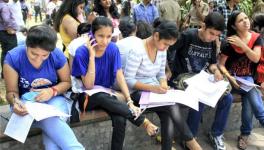Centre’s New Exam System is not Reform but Elite Capture
From this academic session, all undergraduate admissions to central universities will be based on a single test, the Central University Entrance Test, rather than marks obtained in the school leaving board examinations. The University Grants Commission, the primary funding agency for central universities, announced the change barely three months before university admissions, while board examinations were on. To go by what the media reported, the UGC chairman has called the change “student friendly”, and said it will provide a “level playing field” to students writing a variety of state and central board examinations. Both arguments are hackneyed, and frankly, the institution with the mandate to regulate higher education was expected to give more cogent reasoning.
On ‘student friendly’, it is safe to say that Class XII students are likely to feel cheated rather than empowered. To them, it must feel like passing from one stress grinder to another. After two years of online classes during the pandemic, they had only a few months’ breather since January to meet their teachers face-to-face offline. Soon, they plunged into the pre-board preparation tests and the two-phase board examination. Before enjoying even a glimpse of light at the end of this long tunnel, higher education authorities have told them how they do in the board exam will count for nothing and now they must girdle up for another test.
According to one report, students will get only two weeks to prepare for the new test after their board exam, for which they get at least one year to prepare. Now, their fate also depends on five different subject papers. So it is down to two weeks’ preparation and performance in one test. It would have been much more ‘student-friendly’ if the announcement came earlier or the CUET was delayed till 2023.
A much-advertised gripe of college and university administrators is that specific state-level boards boost students’ marks to give them an undue advantage. This brings us to the ‘level playing field’ claim. Last year, one teacher in a college in Delhi University made outrageous remarks to justify the claim about some southern states pushing up the scores of students. Delhi’s Education Minister, too, has joined the bandwagon, with his claim that CUET will allow more students from Delhi to get admission to the University of Delhi. The argument is genetically similar to other right-wing populist views, which are meant to arouse a feeling of victimhood and fear of a conspiracy. It is based on contrived perceptions rather than hard evidence.
First, suppose there is evidence that certain school boards indulge in mischief. In that case, it is the responsibility of school education mandarins at the Centre to make them adopt transparent marking methods. Why force students to go through another wringer of an exam? It is far more likely that after regular coaching, systemic pre-board testing, and family and peer pressure, motivated students all over India are simply better prepared to do well in these exams. A simple statistical exercise to get normalised marks for all boards can take care of any problem with generous marking. The basic assumption of such an exercise is that students across boards, including the toppers, are similarly talented.
On the other hand, a corollary conclusion of the charge that some boards are playing mischief is that students who score high marks from these boards do not deserve them—or admission. Such a suspicion of students’ worth is nothing but prejudice.
If the reasons given for the switch to CUET do not stand rational scrutiny, why is it being implemented urgently? Obviously, the motivations don’t have to be rational either. Further, it appears that understanding the nuances of higher education is not a priority for the administrators of higher education.
Academic Merit and Authoritarian Governance
Notice how similar the move to CUET is with the shock and awe tactics of the Modi regime. We saw similarly sudden moves during the Covid-19 lockdown in March 2020, the withdrawal of currency in November 2016, and the farm laws pushed through suddenly in the summer of 2021. A decision is announced without first thinking through the consequences or discussions with stakeholders. Those affected by the decision are taken for granted. This is the Tughlaqi form of state authority in which mould the mandarins of higher education cast themselves.
A related characteristic of this authoritarian form of power is the mistrust of decentralised decision-making and power-sharing. The emphasis is on uniformity, and higher education is especially prone to the push toward homogeneity. Fairness is used to justify uniformity without any reference to its social context. The critical code word here is ‘merit’, presented as a context neutral personal attribute. To explain, the ideology of academic merit in India rests on two foundations. First is the Savarna caste discourse against the state policy of reservations, which assumes students who seek reservations are less meritorious and deserving.
The second is the extensive culture of fee-based coaching, which helps students from better-off sections prepare for any examination. Their performance in such tests is treated as a mark of their merit. A moment’s reflection on two comparative and realistic scenarios exposes the fallacy that ‘merit’ is an objective or individual attribute, measurable and ranked by performance in an examination. Who has more ‘merit’: A Dalit girl from a family of agricultural labourers studying in a rural government school performs housework yet scores decent grades in the school-leaving examination? Or a child from an affluent metropolitan family who gets driven to school and coaching centre, whose parents are inclined to enable learning at home, and who performs well in the board and university entrance examinations? Both youngsters are likely talented in unique ways. The question and assumption that merit can be measured and ranked through a test are false.
In this context of very diverse learning environments for young Indians, the emphasis on one nationwide entrance examination serves the agenda of elite capture of public resources. The UGC chairman also mentioned that students would not need to write separate entrance examinations for different institutions with CUET. But who are the students who can afford to pay fees, travel and prepare for other entrance examinations? And, if admitted, can they all study anywhere in the country? A student from rural Tamil Nadu is unlikely to apply to a medical college or university in Silchar or Jammu. She is best served if institutions of higher learning are developed near her home. If this requires regionally specific admission criteria, so be it.
Academic Argument for Diversity in Entrance Examinations
There is a proper academic argument about why relying solely on school-leaving board examinations for admission to higher education institutions is not a good practice. School leaving examinations set the minimum level of cognitive skills and knowledge expected in every citizen. There is no reason to assume these skills and knowledge are sufficient for doing well in higher education. Higher education is a super-specialised vocation that relies heavily on self-motivation rather than external rewards and punishments.
Higher education is a conduit for social mobility for individuals from socially and economically marginalised groups and helps members of privileged strata maintain and justify their privileges. Yet, the institutional requirements of higher education are very different from these social functions. This is why higher learning institutions are expected to play a role in deciding who gets to access them. Various admission procedures have evolved in different countries to achieve this goal.
In the United States, performance in standardised multiple-choice based scholastic aptitude test (SAT) is a prime requirement. However, grades in school, independent projects, and letters of recommendation from school teachers also matter. The British A-level exams are integrated with regular school education and include internal assessments. The national baccalauréat examination in France is primarily based on essays and problem-solving questions. It has very few multiple-choice questions and may include an oral component. The Gaokao in China, the most extensive examination that more than 10 million students take every year, has regional variations. Besides MCQs and fill-in-the-blanks, it includes essay-type questions. Higher learning institutions enjoy significant leeway in deciding how to use Gaokao scores for admission.
No admission process to higher education is ideal. Nevertheless, two things stand out from practices in different countries. One, the higher learning institutions and national bodies that manage entrance tests spend a great deal of effort in doing their job, including teachers whose labour grades such examinations. Second, the diversity in the types of questions and assessment modes ensures a more reliable test.
India’s CUET runs counter to both requirements. It will be a single test based only on MCQs, which a computer can easily and readily check. The centralised institute managing it, the National Testing Agency, is neither integrated with school boards, which ideally should prepare students for its examinations nor with universities and other higher learning institutions that admit students which it declares successful. The higher education managers of the country are content with a black-box approach. All they want is some—any—ranking of students to distribute the scarce access to higher education.
The burden of preparing students for entrance tests has been passed on to students and their families, who are forced to rely upon the private commercially-driven coaching industry. Higher education has been divested of any right to decide how and whom to admit. The CUET may be a cheap and ready recipe, but its contribution to the development of higher education is doubtful.
There is a phenomenal increase in first-generation university entrants from India's marginalised social and economic backgrounds. Most such students are in woefully understaffed state universities and affiliated colleges that have few resources. Some students, who perform well in the state board examinations, manage to study in well-funded colleges, like those in the University of Delhi. They get a toehold in these institutions but face several deprivations. An enabling environment should be a top priority for higher education administrators. The CUET does the opposite. Its agenda is to enable elite capture of publicly funded higher education. It is not likely to improve the state of higher education.
The author teaches physics at St Stephen’s College, Delhi. The views are personal
Get the latest reports & analysis with people's perspective on Protests, movements & deep analytical videos, discussions of the current affairs in your Telegram app. Subscribe to NewsClick's Telegram channel & get Real-Time updates on stories, as they get published on our website.























